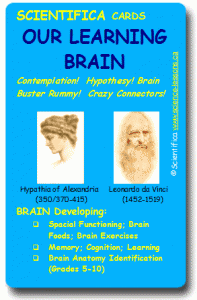 To Hypothesize; to speculate; to believe especially on uncertain or tentative grounds; the first step in the scientific process of providing proof of invented theory. To Think; Famous Genius Hypathia of Alexandria (350/370-415 A.D.) was noted for saying, “Reserve your Right to Think, for to think wrongly is far better than to not think at all”.Our awesome Science Learning Book Our Learning Brain is Now Available in Printed Book Full Color with Amazon Books.
To Hypothesize; to speculate; to believe especially on uncertain or tentative grounds; the first step in the scientific process of providing proof of invented theory. To Think; Famous Genius Hypathia of Alexandria (350/370-415 A.D.) was noted for saying, “Reserve your Right to Think, for to think wrongly is far better than to not think at all”.Our awesome Science Learning Book Our Learning Brain is Now Available in Printed Book Full Color with Amazon Books.
Our Learning Brain includes these 4 Great Games: Brain Buster Rummy; Crazy Connectors! (like Crazy 8’s); Contemplation! (like Solitaire and Patience); and Hypothesy! (An Old-Fashioned A & Q Game). Cards are similar to a traditional playing deck of cards, with 4 suits of 13 cards, all with different facts about each category; and 4 card games; Suitable for Grades 5-10. The games themselves, are easily comprehensible for the earlier grades, while the species identification aspects are brain teasers for the older grades.
CAUTION: Once Students begin, they cannot stop Playing!
Now Available in Printed Book Full Color with Amazon Black & White Version; Printed Book Form Amazon (Click on link for Book Form ordering)
Tasks include achieving Brain Anatomy Identification; Learning . All Science Activities and Games are designed to achieve Elementary and Junior High School Level Science Requirements also including aspects of Mathematics & Communication. Scientifically Proven to Increase Memory & Cognition; Understanding physical properties, structures and changes of Earth materials and Living Organisms and the properties of rocks, soil, water, and air; Identifying and categorizing living organisms; Understanding how components, structures, organizations, and interconnections describe systems; Adding, Reasoning, memory problem solving, and communication; Work collaboratively, find solutions and perform tasks…
And also available through our Blue Butterfly Books site!
Have a Very Merry Christmas! Happy Hannukah! and a Warm Wonderful Winter Solstice!
]]>This week, have your students create a new species, and write about and draw a picture of their animal. Have them examine the qualities of different species, and combine them into what they think would be the most adaptable survivable animal. It could be a “dolphi-gator” – an animal that is half dolphin and half alligator. It could be a “spid-eagle” – a half spider and half eagle.
Share in your elementary classroom, the super powers that your species has and how it could outlive a different species because of its cross-splicing rare abilities. Where does it live? What are its habits? Is it nocturnal? What does it eat? How does it care for its young? Does it have mammalia glands? They could even find photos of their 2 creatures and paste them together to make the new one.
Adapting to our environment is a capability in which we human beings quite excel. Constantly through all the stages of our lives, we break through “limits” that our minds once falsely held. Crawling to walking to running – jumping, driving, skiing, sailing, and flying. If there is one ability we have as a species that makes us different from many other species, it is our ability to adapt to our environment.
The weather changes to hot, cold, damp, dry, wind, and multiple combinations of these – and our bodies adjust our physical temperature to keep all systems stable for continuing our life journey. For some, the number of limbs they have changed (due to unforeseen circumstance), and still they adapt to do the same things they did before, just differently. A newt would grow its arm back. A human being would come up with interesting ways of attaining their food supply with the other arm – maybe use their feet, or become left-handed instead of right.
Is it because of the miracles of our human brain and heart? What makes your new species so adaptable to its natural environment?
For ideas, kids may wish to look at some of our Fun Learning card decks, such as Our Learning Brain, Mammals and Birds:
http://www.science-lessons.ca/games/brain.html.
]]>